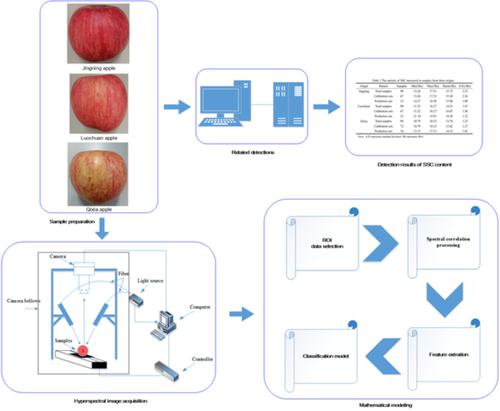当前位置:
X-MOL 学术
›
J. Food Process Eng.
›
论文详情
Our official English website, www.x-mol.net, welcomes your
feedback! (Note: you will need to create a separate account there.)
Research on apple origin classification based on variable iterative space shrinkage approach with stepwise regression–support vector machine algorithm and visible‐near infrared hyperspectral imaging
Journal of Food Process Engineering ( IF 2.7 ) Pub Date : 2020-05-22 , DOI: 10.1111/jfpe.13432 Yan Tian 1, 2 , Jun Sun 1 , Xin Zhou 1 , Xiaohong Wu 1 , Bing Lu 1 , Chunxia Dai 1
Journal of Food Process Engineering ( IF 2.7 ) Pub Date : 2020-05-22 , DOI: 10.1111/jfpe.13432 Yan Tian 1, 2 , Jun Sun 1 , Xin Zhou 1 , Xiaohong Wu 1 , Bing Lu 1 , Chunxia Dai 1
Affiliation

|
Effective classification of apples from different origins is important for horticultural processing and management in mechanized products. To obtain effective characteristic wavelengths and reduce operation time of the classification of apples produced in different areas, a method combining a variable iterative space shrinkage approach with stepwise regression (VISSA‐SR) was proposed. The whole apple sphere was chosen as the region of interest for visible‐near infrared (Vis–NIR) spectral acquisition. Savitzky–Golay smoothing, standard normalized variable, multiplicative scatter correction, and detrending were used to preprocess the spectral data, with their respective effects compared. VISSA, SR, and VISSA‐SR were applied to extract the feature wavelengths. Furthermore, support vector machine (SVM) was utilized in the construction of the identification models. The modeling results demonstrated that a VISSA‐SR‐SVM model based on detrending spectral preprocessing performed best, exhibiting calibration and prediction accuracy rates of 100% and 97.14%, and a modeling time of 131.96 s. The proposed VISSA‐SR algorithm could obtain characteristic wavelength effectively and reduce modeling process operation time. The optimal algorithm combined with Vis–NIR hyperspectral imaging could effectively non‐destructively identify apples from different regions.
中文翻译:

基于变量迭代空间收缩法的逐步回归-支持向量机算法和可见近红外高光谱成像的苹果起源分类研究
对不同来源的苹果进行有效分类对于机械化产品的园艺加工和管理非常重要。为了获得有效的特征波长并减少在不同地区生产的苹果分类的操作时间,提出了一种将可变迭代空间收缩方法与逐步回归相结合的方法(VISSA-SR)。选择整个苹果球作为可见近红外(Vis–NIR)光谱采集的目标区域。Savitzky-Golay平滑,标准归一化变量,乘法散射校正和去趋势用于预处理光谱数据,并比较了它们各自的效果。VISSA,SR和VISSA‐SR用于提取特征波长。此外,支持向量机(SVM)用于识别模型的构建。建模结果表明,基于去趋势频谱预处理的VISSA-SR-SVM模型表现最佳,其校准和预测准确率分别为100%和97.14%,建模时间为131.96 s。提出的VISSA‐SR算法可以有效获取特征波长并减少建模过程的操作时间。结合Vis-NIR高光谱成像的最佳算法可以有效地无损识别不同地区的苹果。提出的VISSA‐SR算法可以有效获取特征波长并减少建模过程的操作时间。结合Vis-NIR高光谱成像的最佳算法可以有效地无损识别不同地区的苹果。提出的VISSA‐SR算法可以有效获取特征波长并减少建模过程的操作时间。结合Vis-NIR高光谱成像的最佳算法可以有效地无损识别不同地区的苹果。
更新日期:2020-05-22
中文翻译:

基于变量迭代空间收缩法的逐步回归-支持向量机算法和可见近红外高光谱成像的苹果起源分类研究
对不同来源的苹果进行有效分类对于机械化产品的园艺加工和管理非常重要。为了获得有效的特征波长并减少在不同地区生产的苹果分类的操作时间,提出了一种将可变迭代空间收缩方法与逐步回归相结合的方法(VISSA-SR)。选择整个苹果球作为可见近红外(Vis–NIR)光谱采集的目标区域。Savitzky-Golay平滑,标准归一化变量,乘法散射校正和去趋势用于预处理光谱数据,并比较了它们各自的效果。VISSA,SR和VISSA‐SR用于提取特征波长。此外,支持向量机(SVM)用于识别模型的构建。建模结果表明,基于去趋势频谱预处理的VISSA-SR-SVM模型表现最佳,其校准和预测准确率分别为100%和97.14%,建模时间为131.96 s。提出的VISSA‐SR算法可以有效获取特征波长并减少建模过程的操作时间。结合Vis-NIR高光谱成像的最佳算法可以有效地无损识别不同地区的苹果。提出的VISSA‐SR算法可以有效获取特征波长并减少建模过程的操作时间。结合Vis-NIR高光谱成像的最佳算法可以有效地无损识别不同地区的苹果。提出的VISSA‐SR算法可以有效获取特征波长并减少建模过程的操作时间。结合Vis-NIR高光谱成像的最佳算法可以有效地无损识别不同地区的苹果。









































 京公网安备 11010802027423号
京公网安备 11010802027423号